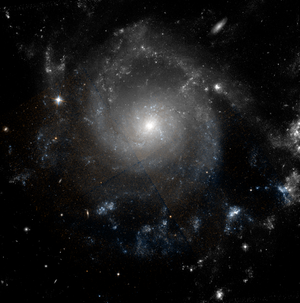NGC 2805
| Galaxy NGC 2805 |
|
|---|---|

|
|
| Photo from the Hubble Space Telescope | |
| AladinLite | |
| Constellation | Big Bear |
|
Position equinox : J2000.0 , epoch : J2000.0 |
|
| Right ascension | 09 h 20 m 20.4 s |
| declination | + 64 ° 06 ′ 10 ″ |
| Appearance | |
| Morphological type | SAB (rs) d |
| Brightness (visual) | 10.9 likes |
| Brightness (B-band) | 11.5 likes |
| Angular expansion | 6.3 ′ × 4.8 ′ |
| Position angle | 140 ° |
| Surface brightness | 14.5 mag / arcmin² |
| Physical data | |
| Affiliation | NGC 2805 group LGG 173 |
| Redshift | 0.005779 ± 0.000002 |
| Radial velocity | (1733 ± 1) km / s |
|
Stroke distance v rad / H 0 |
(81 ± 6) · 10 6 ly (24.9 ± 1.7) Mpc |
| history | |
| discovery | William Herschel |
| Discovery date | April 2, 1791 |
| Catalog names | |
| NGC 2805 • UGC 4936 • PGC 26410 • CGCG 312-002 • MCG + 11-12-003 • IRAS 09162 + 6418 • 2MASX J09202040 + 6406099 • GC 1790 • H III 878 • ASK 446446.0 • HOLM 124B • LDCE 635 NED001 | |
NGC 2805 is a barred spiral galaxy of the Hubble type SBd in the constellation Greater Bear in the northern sky . It is an estimated 81 million light years away from the Milky Way and has a diameter of around 145,000 ly. Together with NGC 2814 , NGC 2820 and IC 2458 , it forms the interactive galaxy quartet Holm 124 .
The object was discovered on April 2, 1791 by the astronomer William Herschel with a 48 cm telescope.
NGC 2805 group ( LGG 173 )
| Galaxy | Alternative name | Distance / million ly |
|---|---|---|
| NGC 2805 | PGC 26410 | 81 |
| NGC 2814 | PGC 26469 | 75 |
| NGC 2820 | PGC 26498 | 74 |
| NGC 2880 | PGC 26939 | 73 |
| IC 2458 | PGC 26485 | 72 |
Web links
Commons : NGC 2805 - collection of images, videos, and audio files
